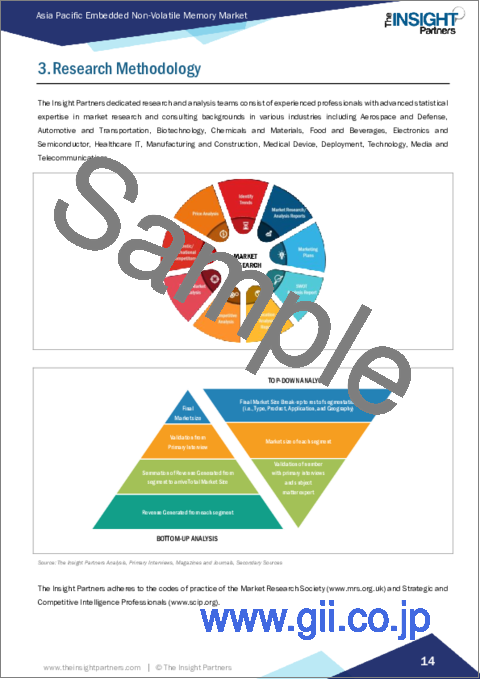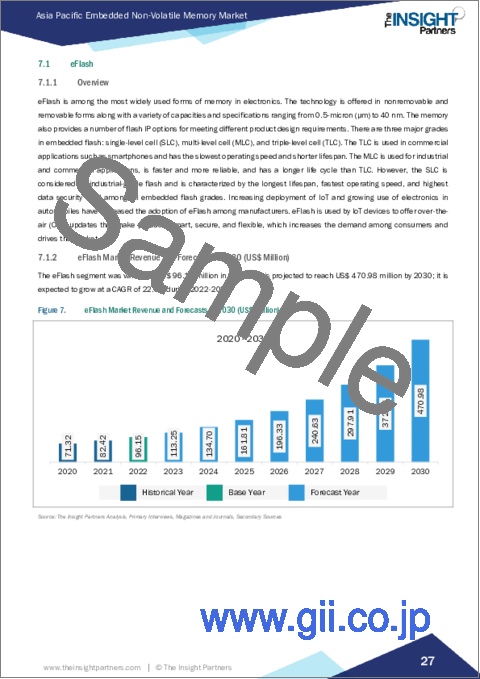|
|
市場調査レポート
商品コード
1533176
アジア太平洋地域の組み込み型不揮発性メモリ:2030年市場予測- 地域別分析- 製品別、用途別Asia Pacific Embedded Non-Volatile Memory Market Forecast to 2030 - Regional Analysis - by Product (eFlash, eE2PROM, FRAM, and Others) and Application (Consumer Electronics, Automotive, Robotics, and Others) |
||||||
|
|||||||
| アジア太平洋地域の組み込み型不揮発性メモリ:2030年市場予測- 地域別分析- 製品別、用途別 |
|
出版日: 2024年06月05日
発行: The Insight Partners
ページ情報: 英文 95 Pages
納期: 即納可能
|
全表示
- 概要
- 図表
- 目次
アジア太平洋地域の組み込み型不揮発性メモリ市場は、2022年に2億9,206万米ドルと評価され、2030年には16億2,179万米ドルに達すると予測され、2022年から2030年にかけて23.9%のCAGRで成長すると予測されています。
低消費電力IoTモジュールの需要増がアジア太平洋地域の組み込み型不揮発性メモリ市場を押し上げる
世界の技術大手は、新技術の研究開発に非常に力を入れています。IoTは、組み込み型不揮発性メモリ市場における次世代ソフトウェア技術の中核に位置付けられています。組み込み型不揮発性メモリは、IoT分野で幅広い用途があります。ユーザーが将来の意思決定活動を行うためのデータを収集・保存するために使用されます。組み込み型不揮発性メモリは、低消費電力のIoTモジュールをサポートすることができます。IoTモジュールの出荷が増加していることが、組み込み型不揮発性メモリ市場に拍車をかけています。例えば、2023年第1四半期には、Telit Cinterion、Quectel、Fibocomなどの企業が低消費電力NB-IoTおよびLTE-M(Cat-M)モジュールの出荷を増やしました。内蔵不揮発性メモリは、モジュールの電圧を調整するためのオンチップとオフチップの必要性を減らすことで、追加のスペースとコストを節約し、IoTモジュールをサポートしています。IoTモジュールは、超低消費電力動作や小型化に関する課題を解決するため、IoTエッジデバイスやエンドポイントデバイスで最も一般的に使用されています。IoTモジュールは、独立して動作しながら、クラウドへの接続、データ・パケットの交換、ファームウェアの一括ダウンロードが可能です。これらのモジュールは、動作を実行するために高いエネルギーと電力を必要とするため、ユーザーの間で組み込み型不揮発性メモリに対する需要が高まっています。さらに、超低消費電力のIoTモジュールに対する需要の高まりは、市場プレーヤーに、動作実行に必要な電力が少ない革新的な組み込み型不揮発性メモリを新たに開発するよう促しています。例えば、STマイクロエレクトロニクスは2022年6月、EEPROM(Electrically Erasable Programmable Read-Only Memory)シリーズを発表しました。EEPROMシリーズは、低電力エネルギーで効果的に動作する組み込みシステムや小型IoTモジュールをサポートする、高密度でオールインワンの新しい組み込み型不揮発性メモリ・ファミリーです。EEPROMシリーズは、効率的なデータ・ロギング、高速アップロード/ダウンロード、消費電力を最小限に抑えながらモジュール効率を高める超低消費電力など、ユーザーにいくつかの利点を提供します。IoTの広範な導入が市場の成長を後押ししています。例えば、Cisco Visual Networking Indexによると、2022年には、組み込みシステムで有効化され、IoTによって駆動されるネットワーク・デバイスは280億台を超えます。ネットワーク機器は、ユーザーが接続性とセキュリティを向上させ、ビジネスの追加運用コストを削減するのに役立ちます。組込みシステムとIoTデバイスやプラットフォームの統合は、スマートホーム、スマートシティ、産業用IoTなどの分野で新たな用途やサービスを可能にしています。また、スマートシティやスマートホームプロジェクトの拡大により、IoTベースの組み込みシステムにおける組み込み型不揮発性メモリの需要が増加すると予想され、市場成長の機会となっています。
アジア太平洋地域の組み込み型不揮発性メモリ市場概要
アジア太平洋地域の組み込み型不揮発性メモリ市場は、中国、インド、オーストラリア、日本、韓国、アジア太平洋地域のその他諸国に区分されます。アジア太平洋地域の組み込み型不揮発性メモリ市場の成長には、大規模な工業化、低労働コスト、有利な経済政策、前向きな経済開拓、外国直接投資(FDI)や外国機関投資(FII)の増加などが寄与しています。台湾と中国は、アジア太平洋地域における主要な半導体製造国です。新興国政府は、メイド・イン・チャイナ2025やメイド・イン・インドといった戦略的イニシアチブを取っており、それぞれの国が自国の需要を満たし、余剰品を輸出できるようにするために、国内製造業の成長を促進しています。さらに、インドや中国などの新興諸国における1人当たりGDPの増加は、スマート・ウェアラブル、家電製品、電気自動車、スマートフォンなどのハイテク家電の大規模な顧客基盤につながっています。多くのアジア経済は、家電、通信機器、自動車部品、その他の産業機械に必要な電子部品やデバイスの大量生産を特徴としています。エリクソンのモビリティ・レポートによると、アジア太平洋地域のモバイル接続は2021年末までに40億から46億に増加すると予想されています。スマートフォンやその他の高度なインターネット対応機器の普及が、アジア太平洋地域における組み込み型不揮発性メモリの需要を押し上げると予想されています。さらに、アジア太平洋地域はスマートフォンの最大の消費者であり、2019年には消費者によって~7億3,200万台が購入されました。通信部門は、主に5Gネットワークの導入に対する前向きな見通しと4Gネットワークの強い存在感により、アジア太平洋で力強い成長を目の当たりにしています。エリクソンのモビリティ・レポートによると、2026年までに西アジアと北東アジアが5G導入全体の66%を占め、東南アジアとオセアニアが32%のシェアを占め、残りのシェアはLTE(4G)技術が占める。この地域は自動車産業が盛んで、インドや韓国などでは自動車製造業が成長しています。中国、インド、韓国、日本などは、世界有数の自動車製造国です。例えば、インドは339万4,446台の自動車を生産し、そのうち293万8,653台が2020年に販売されました。また、2020年には、中国が世界最大の自動車生産国となり、2,522万5,242台を生産し、うち2,531万1,069台が販売されました。さらに、この地域の政府は自動車産業の成長を支援するために様々な取り組みを行っています。例えば、2019年、インド政府は、自動車部門が世界標準を満たせるようにするため、3億8,850万米ドル相当の研究開発センターを設置する計画を発表しました。
アジア太平洋地域の組み込み型不揮発性メモリ市場の収益と2030年までの予測(金額)
アジア太平洋地域の組み込み型不揮発性メモリ市場のセグメンテーション
アジア太平洋地域の組み込み型不揮発性メモリ市場は、製品、用途、国によってセグメント化されます。製品別では、アジア太平洋地域の組み込み型不揮発性メモリ市場は、eFlash、eE2PROM、FRAM、その他に分類されます。eFlashセグメントは2022年に最大の市場シェアを占めました。
用途別では、アジア太平洋地域の組み込み型不揮発性メモリ市場は、家電、自動車、ロボット、その他に分類されます。その他セグメントが2022年に最大の市場シェアを占めました。
国別では、アジア太平洋地域の組み込み型不揮発性メモリ市場は、中国、日本、韓国、インド、オーストラリア、その他アジア太平洋地域に区分されます。2022年のアジア太平洋地域の組み込み型不揮発性メモリ市場シェアは中国が独占。
Microchip Technology Inc、Tower Semiconductor、GlobalFoundries Inc、eMemory Technology Inc、Texas Instruments Inc、Hua Hong Semiconductor Ltd、Taiwan Semiconductor Manufacturing Co Ltd、United Microelectronics Corp、Semiconductor Manufacturing International Corp、Synopsys Incは、アジア太平洋地域の組み込み型不揮発性メモリ市場で事業を展開している大手企業です。
目次
第1章 イントロダクション
第2章 エグゼクティブサマリー
- 主要洞察
- 市場の魅力
第3章 調査手法
- 調査範囲
- 2次調査
- 1次調査
第4章 アジア太平洋地域の組み込み型不揮発性メモリ市場情勢
- エコシステム分析
- バリューチェーンのベンダー一覧
第5章 アジア太平洋地域の組み込み型不揮発性メモリ市場:主要産業力学
- 促進要因
- 家庭用電子機の普及拡大
- 自動車産業の拡大
- 抑制要因
- 世界の半導体チップ不足
- 機会
- 低消費電力IoTモジュールの需要増加
- 動向
- 組み込み型不揮発性メモリの商業化への投資拡大
- 促進要因と抑制要因の影響
第6章 組み込み型不揮発性メモリ市場:アジア太平洋市場分析
- 組み込み型不揮発性メモリ市場の売上高、2022年~2030年
- 組み込み型不揮発性メモリ市場の予測と分析
第7章 アジア太平洋地域の組み込み型不揮発性メモリ市場分析:製品別
- eフラッシュ
- eE2PROM
- FRAM
- その他
第8章 アジア太平洋地域の組み込み型不揮発性メモリ市場分析:用途別
- 家庭用電子機
- 自動車
- ロボット
- その他
第9章 アジア太平洋地域の組み込み型不揮発性メモリ市場:国別分析
- 中国
- 日本
- 韓国
- インド
- オーストラリア
- その他アジア太平洋地域
第10章 競合情勢
- 主要企業別ヒートマップ分析
第11章 業界情勢
- 市場イニシアティブ
- 新製品開発
- 合併と買収
第12章 企業プロファイル
- Microchip Technology Inc
- Tower Semiconductor
- Globalfoundries Inc
- eMemory Technology Inc.
- Texas Instruments Inc
- Hua Hong Semiconductor Limited
- Taiwan Semiconductor Manufacturing Co Ltd
- United Microelectronics Corp
- Semiconductor Manufacturing International Corp
- Synopsys Inc
第13章 付録
List Of Tables
- Table 1. Embedded Non-Volatile Memory Market Segmentation
- Table 2. Embedded Non-Volatile Memory Market Revenue and Forecasts to 2030 (US$ Million)
- Table 3. Embedded Non-Volatile Memory Market Revenue and Forecasts to 2030 (US$ Million) - Product
- Table 4. Embedded Non-Volatile Memory Market Revenue and Forecasts to 2030 (US$ Million) - Application
- Table 5. Asia Pacific Embedded Non-Volatile Memory Market, by Country - Revenue and Forecast to 2030 (USD Million)
- Table 6. China Embedded Non-Volatile Memory Market Revenue and Forecasts to 2030 (US$ Mn) - By Product
- Table 7. China Embedded Non-Volatile Memory Market Revenue and Forecasts to 2030 (US$ Mn) - By Application
- Table 8. Japan Embedded Non-Volatile Memory Market Revenue and Forecasts to 2030 (US$ Mn) - By Product
- Table 9. Japan Embedded Non-Volatile Memory Market Revenue and Forecasts to 2030 (US$ Mn) - By Application
- Table 10. South Korea Embedded Non-Volatile Memory Market Revenue and Forecasts to 2030 (US$ Mn) - By Product
- Table 11. South Korea Embedded Non-Volatile Memory Market Revenue and Forecasts to 2030 (US$ Mn) - By Application
- Table 12. India Embedded Non-Volatile Memory Market Revenue and Forecasts to 2030 (US$ Mn) - By Product
- Table 13. India Embedded Non-Volatile Memory Market Revenue and Forecasts to 2030 (US$ Mn) - By Application
- Table 14. Australia Embedded Non-Volatile Memory Market Revenue and Forecasts to 2030 (US$ Mn) - By Product
- Table 15. Australia Embedded Non-Volatile Memory Market Revenue and Forecasts to 2030 (US$ Mn) - By Application
- Table 16. Rest of Asia Pacific Embedded Non-Volatile Memory Market Revenue and Forecasts to 2030 (US$ Mn) - By Product
- Table 17. Rest of Asia Pacific Embedded Non-Volatile Memory Market Revenue and Forecasts to 2030 (US$ Mn) - By Application
- Table 18. Heat Map Analysis By Key Players
- Table 19. List of Abbreviation
List Of Figures
- Figure 1. Embedded Non-Volatile Memory Market Segmentation, By Country
- Figure 2. Ecosystem: Embedded Non-Volatile Memory Market
- Figure 3. Embedded Non-Volatile Memory Market - Key Industry Dynamics
- Figure 4. Impact Analysis of Drivers and Restraints
- Figure 5. Embedded Non-Volatile Memory Market Revenue (US$ Million), 2022 & 2030
- Figure 6. Embedded Non-Volatile Memory Market Share (%) - Product, 2022 and 2030
- Figure 7. eFlash Market Revenue and Forecasts to 2030 (US$ Million)
- Figure 8. Multimode Market Revenue and Forecasts to 2030 (US$ Million)
- Figure 9. FRAM Market Revenue and Forecasts to 2030 (US$ Million)
- Figure 10. Others Market Revenue and Forecasts to 2030 (US$ Million)
- Figure 11. Embedded Non-Volatile Memory Market Share (%) - Application, 2022 and 2030
- Figure 12. Consumer Electronics Market Revenue and Forecasts to 2030 (US$ Million)
- Figure 13. Automotive Market Revenue and Forecasts to 2030 (US$ Million)
- Figure 14. Robotics Market Revenue and Forecasts to 2030 (US$ Million)
- Figure 15. Others Market Revenue and Forecasts to 2030 (US$ Million)
- Figure 16. Asia pacific Embedded Non-Volatile Memory Market Revenue, By Key Country, (2022), (US$ Million)
- Figure 17. Asia Pacific Embedded Non-Volatile Memory Market Breakdown By Key Countries, 2022 And 2030 (%)
- Figure 18. China Embedded Non-Volatile Memory Market Revenue and Forecasts to 2030 (US$ Mn)
- Figure 19. Japan Embedded Non-Volatile Memory Market Revenue and Forecasts to 2030 (US$ Mn)
- Figure 20. South Korea Embedded Non-Volatile Memory Market Revenue and Forecasts to 2030 (US$ Mn)
- Figure 21. India Embedded Non-Volatile Memory Market Revenue and Forecasts to 2030 (US$ Mn)
- Figure 22. Australia Embedded Non-Volatile Memory Market Revenue and Forecasts to 2030 (US$ Mn)
- Figure 23. Rest of Asia Pacific Embedded Non-Volatile Memory Market Revenue and Forecasts to 2030 (US$ Mn)
The Asia Pacific embedded non-volatile memory market was valued at US$ 292.06 million in 2022 and is expected to reach US$ 1,621.79 million by 2030; it is estimated to grow at a CAGR of 23.9% from 2022-2030.
Increasing Demand in Low-Power IoT Modules Boosts Asia Pacific Embedded Non-Volatile Memory Market
Technological giants worldwide are highly focused on research and development of new technologies. IoT is positioned at the core of the next-gen software technologies in the embedded non-volatile memory market. Embedded non-volatile memory has a wide range of applications in the IoT sector. They are used to collect and store data to help users perform future decision-making activities. An embedded non-volatile memory is capable of supporting low-power IoT modules. The growing shipment of IoT modules is fueling the embedded non-volatile memory market. For instance, in the first quarter of 2023, companies such as Telit Cinterion, Quectel, and Fibocom increased the shipment of low-power NB-IoT and LTE-M (Cat-M) modules. Embedded non-volatile memory supports IoT modules by saving additional space and cost by reducing the need for on- and off-chip to regulate the voltage of the modules. IoT modules are most commonly used in IoT edge or endpoint devices for solving challenges related to ultra-low power operation and shrinking size. IoT modules can connect to the cloud, exchange data packets, and download firmware in batches while operating independently. These modules require high energy and power to perform operations, which increases the demand for embedded non-volatile memory among users. Furthermore, the growing demand for ultra-low power consumption IoT modules encourages market players to develop new innovative embedded non-volatile memory that requires low power to perform operations. For instance, in June 2022, STMicroelectronics launched the Electrically Erasable Programmable Read-Only Memory (EEPROM) series. The EEPROM series is a new high-density, all-in-one embedded non-volatile memory family that supports embedded systems and tiny IoT modules to operate effectively in low-power energy. The EEPROM series offers several benefits to the user, including efficient data logging, fast upload/download, and ultra-low power for enhancing module efficiency while minimizing power dissipation. The extensive adoption of IoT is fueling the market growth. For instance, according to the Cisco Visual Networking Index, in 2022, there were more than 28 billion network devices enabled with embedded systems and powered by IoT. The network devices help users improve connectivity and security and reduce additional operational costs for the business. The integration of embedded systems with IoT devices and platforms is enabling new applications and services in areas such as smart homes, smart cities, and industrial IoT. Also, the expansion of smart cities and smart home projects is anticipated to increase the demand for embedded non-volatile memory in IoT-based embedded systems, thereby providing opportunities for the market growth.
Asia Pacific Embedded Non-Volatile Memory Market Overview
The embedded non-volatile memory market in APAC is segmented into China, India, Australia, Japan, South Korea, and the Rest of APAC. Vast industrialization, low labor cost, favorable economic policies, positive economic development, and an increase in foreign direct investments (FDIs) and foreign institutional investments (FIIs), among others, contribute to the growth of the APAC embedded non-volatile memory market. Taiwan and China are the leading semiconductor manufacturing countries in APAC. The governments of emerging economies have been taking strategic initiatives, such as Made in China 2025 and make in India, to promote the growth of the domestic manufacturing sectors for making the respective countries capable of meeting the native demands and exporting surplus goods. Moreover, the rising GDP per capita in developing countries, such as India and China, leads to a large client base for high-tech consumer electronics such as smart wearables, appliances, electric vehicles, and smartphones. Many Asian economies are characterized by the mass production of electronic components or devices required for consumer electronics, telecommunication devices, automotive components, and other industrial machinery. As per the Ericsson Mobility Report, their mobile connections in APAC are expected to rise from ~4 billion to 4.6 billion by the end of 2021. An increase in the adoption of smartphones and other advanced internet-enabled devices is anticipated to boost the demand for embedded non-volatile memory in APAC. Moreover, APAC is the biggest consumer of smartphones, as ~732 million units were bought by consumers in 2019. The telecommunication sector is witnessing strong growth in Asia Pacific mainly due to the positive outlook toward introducing 5G networks and the strong presence of 4G networks. According to Ericsson's mobility report, Western and Northeast Asia would account for 66% share of the total 5G adoption by 2026, while Southeast Asia and Oceania would hold 32% share by 2026; the rest of the shares would be held by the LTE (4G) technology. The region has a robust automotive sector, which is followed by the growing automotive manufacturing industry in countries such as India and South Korea. Countries such as China, India, South Korea, and Japan are among the leading vehicle manufacturing countries worldwide. For instance, India produced 3,394,446 vehicles, of which 2,938,653 were sold in 2020. Also, in 2020, China was the largest vehicle-producing country globally; it produced 25,225,242 vehicles in 2020, of which 25,311,069 were sold. Moreover, the governments in this region are undertaking various initiatives to support the automotive industry's growth. For instance, in 2019, the government of India announced its plan to set up research and development centers worth US$ 388.5 million to enable the automotive sector to meet global standards.
Asia Pacific Embedded Non-Volatile Memory Market Revenue and Forecast to 2030 (US$ Million)
Asia Pacific Embedded Non-Volatile Memory Market Segmentation
The Asia Pacific embedded non-volatile memory market is segmented based on product, application, and country. Based on product, the Asia Pacific embedded non-volatile memory market is categorized into eFlash, eE2PROM, FRAM, and others. The eFlash segment held the largest market share in 2022.
In terms of application, the Asia Pacific embedded non-volatile memory market is categorized into consumer electronics, automotive, robotics, and others. The others segment held the largest market share in 2022.
Based on country, the Asia Pacific embedded non-volatile memory market is segmented into China, Japan, South Korea, India, Australia, and the Rest of Asia Pacific. China dominated the Asia Pacific embedded non-volatile memory market share in 2022.
Microchip Technology Inc, Tower Semiconductor, GlobalFoundries Inc, eMemory Technology Inc, Texas Instruments Inc, Hua Hong Semiconductor Ltd, Taiwan Semiconductor Manufacturing Co Ltd, United Microelectronics Corp, Semiconductor Manufacturing International Corp, and Synopsys Inc are some of the leading companies operating in the Asia Pacific embedded non-volatile memory market.
Table Of Contents
1. Introduction
- 1.1 The Insight Partners Research Report Guidance
- 1.2 Market Segmentation
2. Executive Summary
- 2.1 Key Insights
- 2.2 Market Attractiveness
3. Research Methodology
- 3.1 Coverage
- 3.2 Secondary Research
- 3.3 Primary Research
4. Asia Pacific Embedded Non-Volatile Memory Market Landscape
- 4.1 Overview
- 4.2 Ecosystem Analysis
- 4.2.1 List of Vendors in Value Chain:
5. Asia Pacific Embedded Non-Volatile Memory Market - Key Industry Dynamics
- 5.1 Drivers
- 5.1.1 Increase in Adoption of Consumer Electronics
- 5.1.2 Expansion of Automotive Industry
- 5.2 Restraints
- 5.2.1 Global Shortage of Semiconductor Chips
- 5.3 Opportunities
- 5.3.1 Increasing Demand in Low-Power IoT Modules
- 5.4 Trends
- 5.4.1 Growing Investment in Commercialization of Embedded Non-Volatile Memory
- 5.5 Impact of Drivers and Restraints:
6. Embedded Non-Volatile Memory Market - Asia Pacific Market Analysis
- 6.1 Embedded Non-Volatile Memory Market Revenue (US$ Million), 2022 - 2030
- 6.2 Embedded Non-Volatile Memory Market Forecast and Analysis
7. Asia Pacific Embedded Non-Volatile Memory Market Analysis - Product
- 7.1 eFlash
- 7.1.1 Overview
- 7.1.2 eFlash Market Revenue and Forecasts to 2030 (US$ Million)
- 7.2 eE2PROM
- 7.2.1 Overview
- 7.2.2 eE2PROM Market Revenue and Forecasts to 2030 (US$ Million)
- 7.3 FRAM
- 7.3.1 Overview
- 7.3.2 FRAM Market Revenue and Forecasts to 2030 (US$ Million)
- 7.4 Others
- 7.4.1 Overview
- 7.4.2 Others Market Revenue and Forecasts to 2030 (US$ Million)
8. Asia Pacific Embedded Non-Volatile Memory Market Analysis - Application
- 8.1 Consumer Electronics
- 8.1.1 Overview
- 8.1.2 Consumer Electronics Market Revenue and Forecasts to 2030 (US$ Million)
- 8.2 Automotive
- 8.2.1 Overview
- 8.2.2 Automotive Market Revenue and Forecasts to 2030 (US$ Million)
- 8.3 Robotics
- 8.3.1 Overview
- 8.3.2 Robotics Market Revenue and Forecasts to 2030 (US$ Million)
- 8.4 Others
- 8.4.1 Overview
- 8.4.2 Others Market Revenue and Forecasts to 2030 (US$ Million)
9. Asia Pacific Embedded Non-Volatile Memory Market - Country Analysis
- 9.1 Asia Pacific Embedded Non-Volatile Memory Market
- 9.1.1 Overview
- 9.1.2 Embedded Non-Volatile Memory Market Breakdown by Countries
- 9.1.2.1 China Embedded Non-Volatile Memory Market Revenue and Forecasts to 2030 (US$ Mn)
- 9.1.2.1.1 China Embedded Non-Volatile Memory Market Breakdown by Product
- 9.1.2.1.2 China Embedded Non-Volatile Memory Market Breakdown by Application
- 9.1.2.2 Japan Embedded Non-Volatile Memory Market Revenue and Forecasts to 2030 (US$ Mn)
- 9.1.2.2.1 Japan Embedded Non-Volatile Memory Market Breakdown by Product
- 9.1.2.2.2 Japan Embedded Non-Volatile Memory Market Breakdown by Application
- 9.1.2.3 South Korea Embedded Non-Volatile Memory Market Revenue and Forecasts to 2030 (US$ Mn)
- 9.1.2.3.1 South Korea Embedded Non-Volatile Memory Market Breakdown by Product
- 9.1.2.3.2 South Korea Embedded Non-Volatile Memory Market Breakdown by Application
- 9.1.2.4 India Embedded Non-Volatile Memory Market Revenue and Forecasts to 2030 (US$ Mn)
- 9.1.2.4.1 India Embedded Non-Volatile Memory Market Breakdown by Product
- 9.1.2.4.2 India Embedded Non-Volatile Memory Market Breakdown by Application
- 9.1.2.5 Australia Embedded Non-Volatile Memory Market Revenue and Forecasts to 2030 (US$ Mn)
- 9.1.2.5.1 Australia Embedded Non-Volatile Memory Market Breakdown by Product
- 9.1.2.5.2 Australia Embedded Non-Volatile Memory Market Breakdown by Application
- 9.1.2.6 Rest of Asia Pacific Embedded Non-Volatile Memory Market Revenue and Forecasts to 2030 (US$ Mn)
- 9.1.2.6.1 Rest of Asia Pacific Embedded Non-Volatile Memory Market Breakdown by Product
- 9.1.2.6.2 Rest of Asia Pacific Embedded Non-Volatile Memory Market Breakdown by Application
- 9.1.2.1 China Embedded Non-Volatile Memory Market Revenue and Forecasts to 2030 (US$ Mn)
10. Competitive Landscape
- 10.1 Heat Map Analysis By Key Players
11. Industry Landscape
- 11.1 Overview
- 11.2 Market Initiative
- 11.3 New Product Development
- 11.4 Merger and Acquisition
12. Company Profiles
- 12.1 Microchip Technology Inc
- 12.1.1 Key Facts
- 12.1.2 Business Description
- 12.1.3 Products and Services
- 12.1.4 Financial Overview
- 12.1.5 SWOT Analysis
- 12.1.6 Key Developments
- 12.2 Tower Semiconductor
- 12.2.1 Key Facts
- 12.2.2 Business Description
- 12.2.3 Products and Services
- 12.2.4 Financial Overview
- 12.2.5 SWOT Analysis
- 12.2.6 Key Developments
- 12.3 Globalfoundries Inc
- 12.3.1 Key Facts
- 12.3.2 Business Description
- 12.3.3 Products and Services
- 12.3.4 Financial Overview
- 12.3.5 SWOT Analysis
- 12.3.6 Key Developments
- 12.4 eMemory Technology Inc.
- 12.4.1 Key Facts
- 12.4.2 Business Description
- 12.4.3 Products and Services
- 12.4.4 Financial Overview
- 12.4.5 SWOT Analysis
- 12.4.6 Key Developments
- 12.5 Texas Instruments Inc
- 12.5.1 Key Facts
- 12.5.2 Business Description
- 12.5.3 Products and Services
- 12.5.4 Financial Overview
- 12.5.5 SWOT Analysis
- 12.5.6 Key Developments
- 12.6 Hua Hong Semiconductor Limited
- 12.6.1 Key Facts
- 12.6.2 Business Description
- 12.6.3 Products and Services
- 12.6.4 Financial Overview
- 12.6.5 SWOT Analysis
- 12.6.6 Key Developments
- 12.7 Taiwan Semiconductor Manufacturing Co Ltd
- 12.7.1 Key Facts
- 12.7.2 Business Description
- 12.7.3 Products and Services
- 12.7.4 Financial Overview
- 12.7.5 SWOT Analysis
- 12.7.6 Key Developments
- 12.8 United Microelectronics Corp
- 12.8.1 Key Facts
- 12.8.2 Business Description
- 12.8.3 Products and Services
- 12.8.4 Financial Overview
- 12.8.5 SWOT Analysis
- 12.8.6 Key Developments
- 12.9 Semiconductor Manufacturing International Corp
- 12.9.1 Key Facts
- 12.9.2 Business Description
- 12.9.3 Products and Services
- 12.9.4 Financial Overview
- 12.9.5 SWOT Analysis
- 12.9.6 Key Developments
- 12.10 Synopsys Inc
- 12.10.1 Key Facts
- 12.10.2 Business Description
- 12.10.3 Products and Services
- 12.10.4 Financial Overview
- 12.10.5 SWOT Analysis
- 12.10.6 Key Developments
13. Appendix
- 13.1 Word Index





